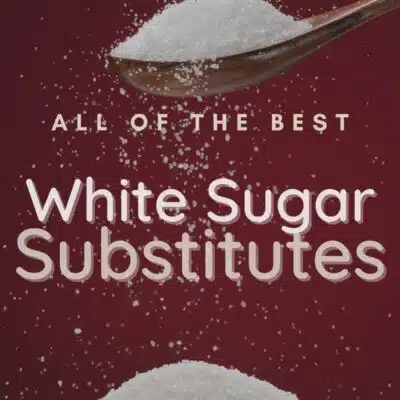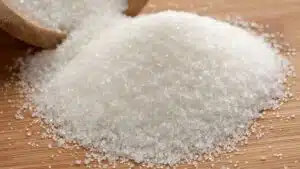A white sugar substitute can be crucial when trying to prepare your favorite foods in a healthier way that is just as tasty! This article will explore the different types of white sugar substitutes, their benefits, and how to use them in your well-loved recipes. Now you can make the switch to a sugar-free alternative without having to worry about taste!
Alternatives For White Sugar
Granulated white sugar has been a staple ingredient in kitchens worldwide for centuries. However, with an increasing number of people becoming health-conscious and seeking alternatives to traditional sugar, there has been a rise in demand for sugar substitutes.
Whether you are looking to reduce your sugar intake, manage diabetes, or simply try something new, this article will provide you with valuable information on how to make the switch to a healthier alternative without sacrificing taste. Let's get started!

Jump to:
- Alternatives For White Sugar
- Best Sugar Substitutes
- 1. Stevia
- Table 1: Stevia Conversion Table
- 2. Erythritol
- 3. Xylitol
- 4. Monk Fruit
- 5. Coconut Sugar
- 6. Sucralose
- 7. Agave Nectar
- 8. Maple Syrup
- 9. Date Sugar
- 10. Brown Rice Syrup
- 11. Yacon Syrup
- 12. Honey
- Table 2: Sugar Substitutes, Uses & Attributes
- Which Sugar Substitute Is Best For Baking
- 📖 Recipe Card
- 💬 Comments & Reviews
Best Sugar Substitutes
When it comes to cooking and baking, finding the right sugar substitute can be essential for maintaining texture, flavor, and consistency. Here is a complete list of sugar substitutes suitable for both cooking and baking.
1. Stevia
A natural, zero-calorie sweetener that works well in both baking and cooking. However, it's important to use a brand specifically designed for these purposes due to its high sweetness intensity. It is available in liquid, powder, and granulated forms.
Since it is sweeter than sugar (typically about 250 times sweeter), start with less and add more as needed.
Table 1: Stevia Conversion Table
| Sugar | Liquid Stevia | Stevia Packets | Granulated Stevia | Stevia Powder |
| 1 teaspoon | 1 ml | ½ packet | ⅛ tsp | 20 mg |
| 1 tablespoon | 3 ml | 1½ packets | ⅓ tsp | 60 mg |
| ½ cup | 24 ml | 12 packets | 1 Tbsp | ⅛ tsp |
| 1 cup | 48 ml | 24 packets | 2 Tbsp | ¼ tsp |
2. Erythritol
A sugar alcohol with zero calories and a low glycemic index, erythritol is about 70% as sweet as sugar. It's heat-stable which makes it an excellent option for baking and cooking.
Depending on the brand, it can be used in a 1:1 swap for white granulated sugar.
*It should also be noted that erythritol has recently been in the news for potential heart health risks. Research these issues yourself and speak with your doctor about any side effects or issues.
3. Xylitol
Another sugar alcohol, xylitol, has a sweetness similar to sugar and works well in cooking and baking. However, it can cause gastrointestinal issues if consumed in large quantities and is highly toxic to dogs.
4. Monk Fruit
A natural sweetener derived from monk fruit, it's available in granulated form, making it easy to use in cooking and baking. Use a brand specifically designed for cooking; note that it is much sweeter than sugar.
The ratio needed depends on the brand you purchase, as some brands can be swapped in a 1:1 ratio. Make sure to check the packaging of your monk fruit sweetener.
5. Coconut Sugar
Made from the sap of coconut palm trees, coconut sugar has a lower glycemic index than regular sugar and can be used as a 1:1 substitute in recipes. Its caramel-like flavor makes it one of my favorites for baking.
>>>>See all of my recipes here<<<<
6. Sucralose
A heat-stable artificial sweetener, sucralose is suitable for cooking and baking. It's available in granulated form and can be used as a 1:1 sugar substitute, but it may have a slightly different aftertaste.
7. Agave Nectar
A natural liquid sweetener, agave nectar can be used in cooking and baking. It's sweeter than sugar, so use less when substituting. Remember that it may alter the texture of some baked goods due to its liquid form.
8. Maple Syrup
A natural liquid sweetener, maple syrup can be used in cooking and baking. It adds a distinct maple flavor and has a lower glycemic index than sugar. Adjust the quantity and other liquid ingredients in recipes accordingly.
9. Date Sugar
Made from dried, ground dates, date sugar can be used in baking as a 1:1 substitute for sugar. However, it doesn't dissolve well in liquids, so it's not suitable for all recipes.
10. Brown Rice Syrup
A liquid sweetener derived from brown rice, it's less sweet than sugar and has a higher glycemic index. It can be used in cooking and baking, but adjustments to the quantity and other liquid ingredients may be necessary.
11. Yacon Syrup
Derived from the yacon root, this natural sweetener has a low glycemic index and can be used in cooking and baking. It's not as sweet as sugar, so adjust the quantity accordingly.
12. Honey
Honey is a natural sweetener that is sweeter than white sugar and has a distinct taste that varies based on region and processing methods. Since it is only available as a liquid, your recipe may need some alterations to work properly.
Table 2: Sugar Substitutes, Uses & Attributes
| Sugar Substitute | Best Uses | Attributes |
|---|---|---|
| Stevia | Beverages, baking, cooking | Zero-calorie, natural, up to 300 times sweeter than sugar, doesn't raise blood sugar levels |
| Erythritol | Baking, cooking, beverages | Zero-calorie, sugar alcohol, 70% as sweet as sugar, heat-stable, low glycemic index |
| Xylitol | Baking, cooking, oral care | Similar sweetness to sugar, sugar alcohol, heat-stable, low glycemic index, toxic to dogs |
| Monk Fruit | Baking, cooking, beverages | Zero-calorie, natural, 100-250 times sweeter than sugar, low glycemic index |
| Coconut Sugar | Baking, cooking | Lower glycemic index than sugar, 1:1 sugar substitute, caramel-like flavor |
| Sucralose | Baking, cooking, beverages | Zero-calorie, artificial, 600 times sweeter than sugar, heat-stable, slight aftertaste |
| Agave Nectar | Baking, cooking, beverages | Natural, sweeter than sugar, lower glycemic index, liquid form may affect texture in baking |
| Maple Syrup | Baking, cooking, breakfast | Natural, distinct maple flavor, lower glycemic index, liquid form may require adjustments in recipes |
| Date Sugar | Baking | Natural, made from ground dates, 1:1 sugar substitute, doesn't dissolve well in liquids |
| Brown Rice Syrup | Baking, cooking, granola bars | Natural, less sweet than sugar, higher glycemic index, liquid form may require adjustments in recipes |
| Yacon Syrup | Baking, cooking, beverages | Natural, low glycemic index, less sweet than sugar, derived from yacon root |
| Honey | Baking, cooking, beverages, dressings | Natural, sweeter than sugar, liquid form may require adjustments in recipes |
Which Sugar Substitute Is Best For Baking
Determining the best sugar substitute for baking depends on your specific needs, preferences, and dietary restrictions.
Remember that sugar substitutes may affect your dishes' taste, texture, and appearance, so it's crucial to experiment and adjust your recipes accordingly. Some sugar substitutes may also have specific temperature and moisture requirements, so follow the manufacturer's guidelines.
These white sugar substitutes are great for any recipe you may have! Choose the one that works the best for you, and enjoy! Leave a comment down below and let me know what you think!
Do you love a recipe you tried? Please leave a 5-star 🌟rating in the recipe card below and/or a review in the comments section further down the page.
Stay in touch with me through social media @ Pinterest, Facebook, Instagram, or Twitter! Subscribe to the newsletter today (no spam, I promise)! Don't forget to tag me when you try one of my recipes!
📖 Recipe Card
Best White Sugar Substitute: Monkfruit (+More Great Alternatives!)
Ingredients
- 1 cup monk fruit sweetener (brand made for baking)
- 1 cup coconut sugar
- 1 cup sucralose (granulated)
(Note: 2x or 3x only changes the ingredient list)
Instructions
- Use monk fruit in a 1:1 swap for white sugar, depending on the brand.
- Use coconut sugar in a 1:1 swap for white sugar in your favorite recipes.
- Use sucralose in a 1:1 swap for white sugar in baking and cooking.



Comments
No Comments